The Rocket Roundup team takes a look back at the rockets that launched in 2021, with a review of the statistics and some highlights (including that one telescope that could have ruined Christmas).
Podcast
Show Notes
Mitsubishi Heavy Industries- Inmarsat 6 F1 Press Release
Starlink Statistics- Johnathan McDowell’s Planet4859
Mars Ingenuity Helicopter Flight Log
NASA Perseverance Rover 2021 Year In Review-Video
People in Space Record broken twice-Article
Transcript
Hello, and welcome to the Daily Space. I am your host Dr Pamela Gay.
And I am your host Erik Madaus, and most weekdays the CosmoQuest team is here putting science in your brain.
Today, however, is for Rocket Roundup.
Let’s get to it, shall we?
Before we begin the annual year in review episode, I wanted to give you a quick update on some launches that happened during our break. (Because everything launches the moment we go on break!)
There were a total of nine launch attempts from six countries. China was responsible for nearly half of the end-of-year launches, sending off four rockets — a Long March 7A, 4C,2D, and 3B — in three days. The other five launches originated from Iran, Japan, Kazakhstan, Russia, and French Guiana, with one launch each.
Iran launched another Simorgh rocket with three satellites. It almost made it into orbit, reaching a velocity of 7,350 m/s.
From Japan, a H-IIA launched the commercial Inmarsat 6 satellite, marking their third launch of the year.
A Soyuz 2.1b Fregat put another batch of 36 OneWeb satellites into orbit from Baikonur, Kazakhstan.
Russia launched the third test flight of the Angara A5. The Persei upper stage, which is a special variant of the Block D upper stage for Angara, rocket failed to restart, stranding the dummy payload in low Earth orbit, nowhere near the geostationary graveyard orbit it was intended to go to. It is expected to reenter the atmosphere sometime later today, January 5.
From French Guiana, an Ariane 5 launched on Christmas Day, finally putting the JWST into space. After fifteen years of planning, development, and delays, it’s finally begun its one month journey to Lagrange Point 2. (More on that later!)
2021 was another rough year for pretty much everyone. In case you missed it, there’s a pandemic going on, supply chain issues abound, and there is still a microchip shortage.
Despite that, the space industry achieved a lot. There were 145 orbital launch attempts — the most since 1967. Most, 133, were successful. We keep track of orbital launches by launch location, also known as spaceport. Please keep in mind that these numbers do not include suborbital flights, such as the Starship tests or New Shepard.
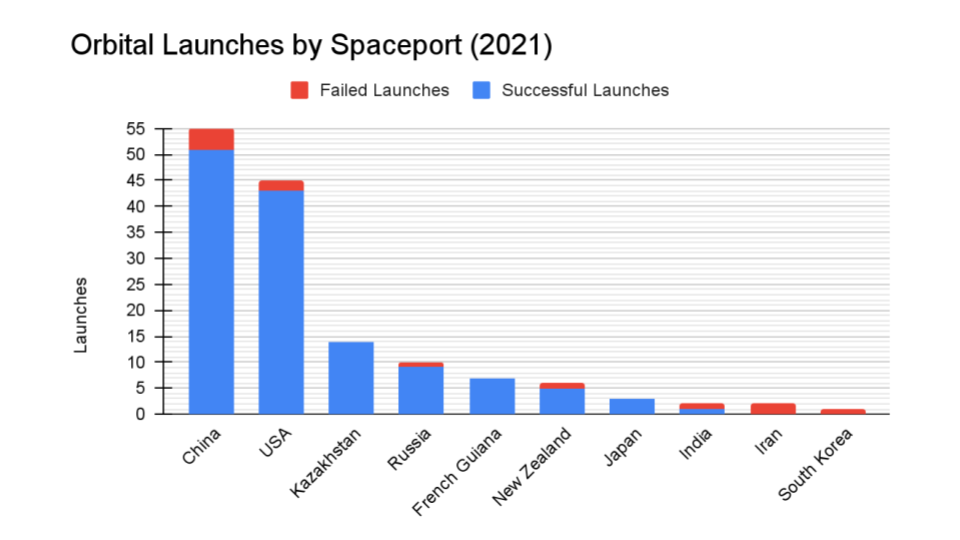
The 2021 totals were:
China 55
USA 45
Kazakhstan 14
Russia 10
French Guiana 7
New Zealand 6
Japan 3
India 2
Iran 2
South Korea 1
Like in 2020, China launched more rockets than anyone else, closely followed by the US. Thirty one out of 45 US launches were SpaceX launches. Five of the Falcon 9 boosters launched more times than rockets by several individual countries. In fact, Booster 1060 launched six times just last year, matching the total combined number of launches by South Korea, India, and Japan.
The smallest rocket launched in 2021 was Astra’s Rocket 3.3, and the largest rocket launched was United Launch Alliance’s Delta 4 Heavy.
From the 133 successful launches, the most ever in a year, 27 humans were put into orbit as well as 1,778 spacecraft and satellites. Additionally, 16,675 kilograms of cargo was sent to the International Space Station (ISS). That’s the equivalent of three elephants sent to space to a place the size of an average house. Two spacecraft left Earth for destinations around the solar system: NASA’s Lucy to the Jupiter Trojans and the DART mission to the binary asteroid Didymos.
Last year, 989 SpaceX Starlink satellites were launched across nineteen different launches, making up almost 60% of all satellites launched in 2021. Since 2019, a total of 1,944 Starlink satellites have been launched, including the Tintin and v0.9 series. As of December 31, 1,764 are currently functional with 151 reentered and 29 more on their way back into the atmosphere.
The first shell of the Starlink constellation was finally completed in late May with nearly 1600 satellites in 53 degree inclination orbits. After an extended downtime another several hundred satellites were launched for the 70 degree and 53.2 degree shells. These launches will continue into 2022 and beyond. The final Starlink constellation will eventually consist of over 4000 satellites.
In addition SpaceX launched two smallsat rideshare missions named Transporter 1 and Transporter 2 in January and June 2021 respectively. Transporter 1 broke the record for most satellites put into orbit on one rocket with a total of 143 satellites. In comparison, Transporter 2 had a mere 85 satellites. I know that sounds impressive, but keep in mind that most of them were about the size of a shoebox or smaller.
A lot of the launches in 2021 were for various satellite constellations. A constellation is a group of satellites put into different orbits which work together for different purposes, like navigation or communications.
OneWeb, which is another satellite internet provider, has its constellation much closer to completion than its competitor, Starlink. Last year, Russian Soyuz rockets launched 284 more satellites in seven launches from both the Vostochny and Baikonur Cosmodrome’s for a total of 394 satellites in orbit, or 60% complete.
The European Union’s Galileo constellation got one step closer to completion with two more satellites launched in late 2021, satellites 27 and 28.
Speaking of satellite navigation constellations, the United States’ GPS III constellation had one more satellite launch in 2021. Further satellites were delayed because of the ongoing pandemic.
Black Sky Global doubled their constellation of imaging satellites after a series of dedicated launches of Electron rockets and one SpaceX rideshare.
It’s more difficult to keep track of how many of them are in orbit or how many satellites the total constellation will be but Planet Labs kept launching Flocks of their Dove imaging satellites into orbit, 48 on SpaceX’s Transporter 1 and 44 on Transporter 2.
There were a lot of satellites launched, but there were also a lot of records set in 2021.
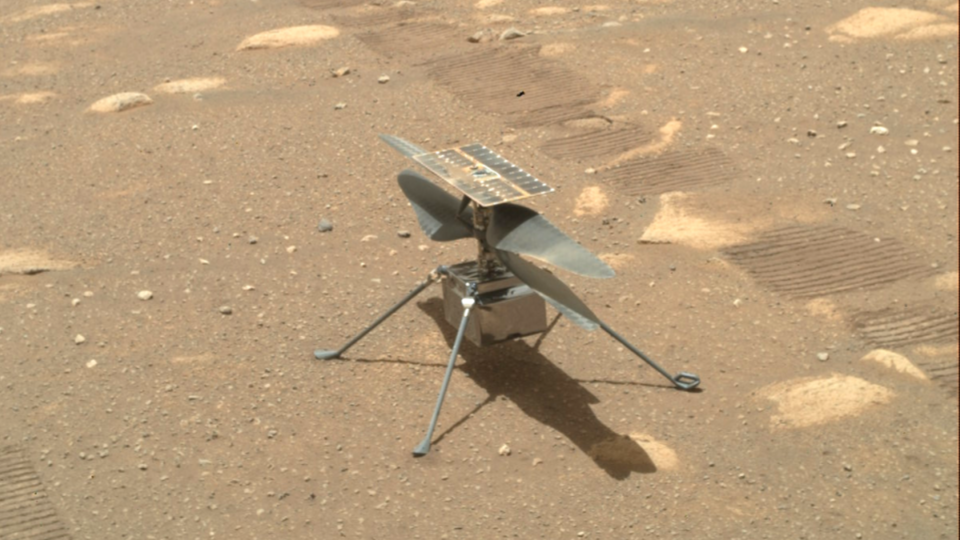
Many new space records were set in 2021, most notably the first powered flight on another planet. NASA’s Mars Ingenuity helicopter has traveled almost three kilometers over the Martian surface during its eighteen flights and reached a top speed of over 20 knots. Other firsts include the first reuse of a crewed capsule and first flight of a reused capsule on a reused booster, on the SpaceX Crew 2 missions. Finally, the first orbital spaceflight with only private citizens onboard, Inspiration 4, launched in September.
2021 was the year of Martian arrivals as well. After a roughly six-month trip, three missions that launched in 2020 arrived at Mars. These included NASA’s Perseverance Rover, the United Arab Emirates Hope orbiter, and China’s first successful Mars orbiter, Tianwen-1 with a lander/rover combo called Zhurong. NASA’s Curiosity and Perseverance rovers both drove about three kilometers over the Martian surface during the year. Perseverance, the newer of the two rovers set a record for the longest drive on a Martian day and the fastest rover on Mars. So far, it has collected six samples of rock and atmosphere during its first ten months on Mars.
2021 was also the year of the space station, with Russia launching two new modules to the International Space Station: Nauka and Prichal. Nauka’s arrival was exciting — and not in a good way. After it docked with the ISS, the thrusters did not shut off which spun the entire station five hundred and forty degrees on its long axis. Before it could get much worse, the thrusters ran out of propellant and stopped firing. No astronauts or cosmonauts were harmed during the joy ride.
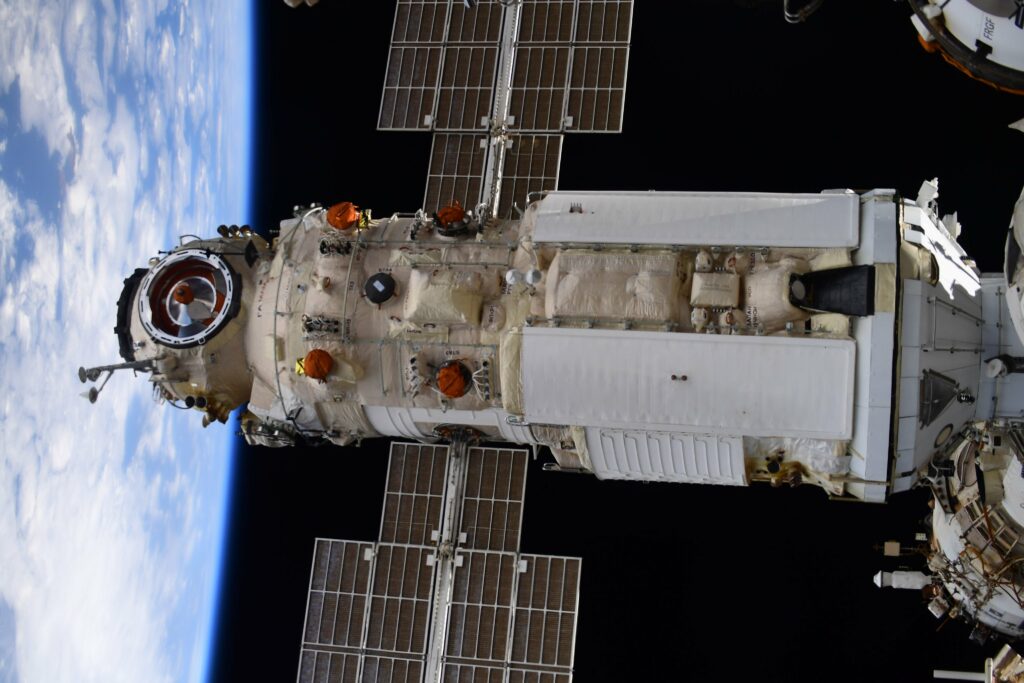
The arrival of the Prichal node module was much less stressful. It simply launched and docked without any trouble.
In order to make room for Nauka, the Pirs module was retired. It was undocked from the station on July 26 and deorbited by a Progress spacecraft to burn up in the atmosphere. This was the first retirement of a permanent ISS module.
China launched the first module of their new space station. The launch of Tianhe left the Long March 5B rocket’s core stage in orbit to decay uncontrolled. After a few days it burnt up over the Indian Ocean — fortunately not hitting anyone or anything.
Since launch the station has been visited by six astronauts in two crewed spacecraft, Shenzhou 12 and 13. It has also hosted two uncrewed resupply spacecraft: Tianzhou 2 and 3. Shenzhou 12 tripled the amount of time a Chinese crew spent in space on a single mission with a 90-day flight. Shenzhou 13, currently in orbit, is expected to double to 180 days in space.
From stations that were launched into space to the people that went to it, for work or pleasure.
Forty-eight people went into space in 2021 across eight orbital and five suborbital space flights. Twenty-one of these people (one posthumously) were awarded FAA Commercial Astronaut wings following their flights on US space tourist vehicles. The rest were not eligible because they were either professional astronauts or not Americans.
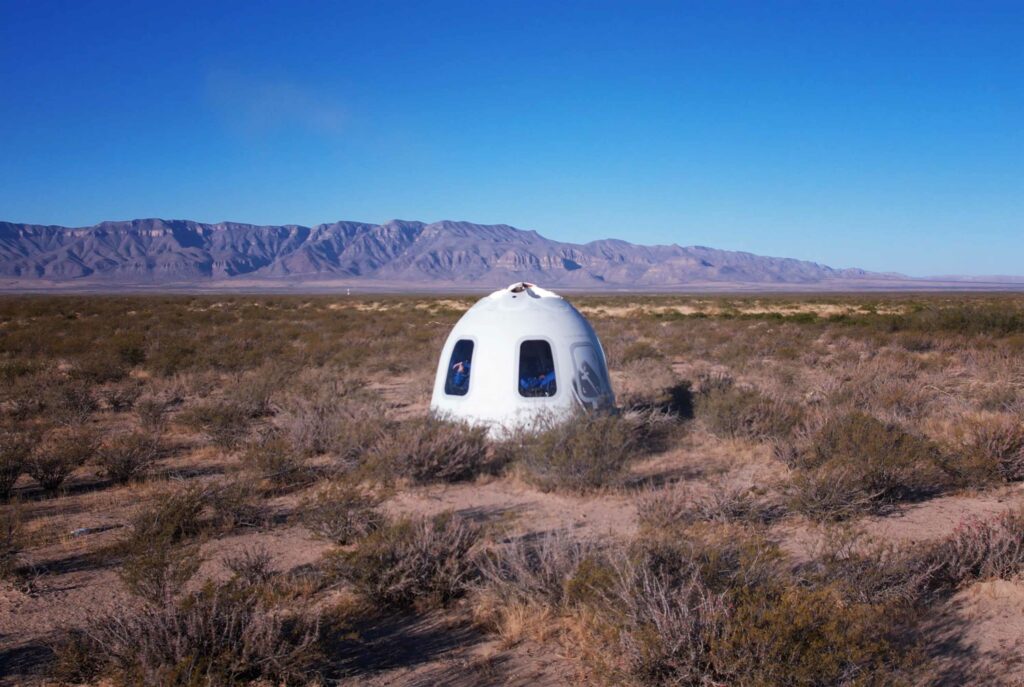
The commercial space tourism industry finally got serious in 2021, with Blue Origin’s New Shepard making its first three revenue flights. Virgin Galactic’s SpaceShipTwo also made several crewed flights including the first human spaceflight from New Mexico, but it has yet to begin regular service.
Last year also marked the resumption of tourist flights to the ISS on the Russian Soyuz, now that NASA astronauts have their own ride again. The last tourist to catch a ride on a Soyuz was Canadian Guy Laliberté back in 2009. There were two tourist flights last year: a pair of Russian filmmakers went up in October and a Japanese billionaire and his assistant in December.
2021 was also a year for setting records.
The record for most people in space at one time was broken not once, but twice last year. The first was in September when Inspiration 4, Soyuz MS-18, SpaceX Crew 2 and Shenzhou 12 were in orbit, totalling fourteen people for four days. The second time was in December when the New Shepard suborbital rocket joined Soyuz MS-19, SpaceX Crew 3 and Shenzhou 13 above the Kármán line, making nineteen people in space for about 11 minutes.
The record for oldest person in space was also broken twice in 2021, first by 82 year old Wally Funk in July and second by 90 year old William Shatner in October, both on New Shepard flights.
Fifteen spacewalks were conducted by sixteen individual astronauts on the two active space stations. The spacewalks for the ISS included tasks like adding new solar panels, replacing old batteries, and preparing it for the new modules that arrived last year. The spacewalks for the Chinese Space Station included the first spacewalk by a Chinese woman, Wang Yaping.
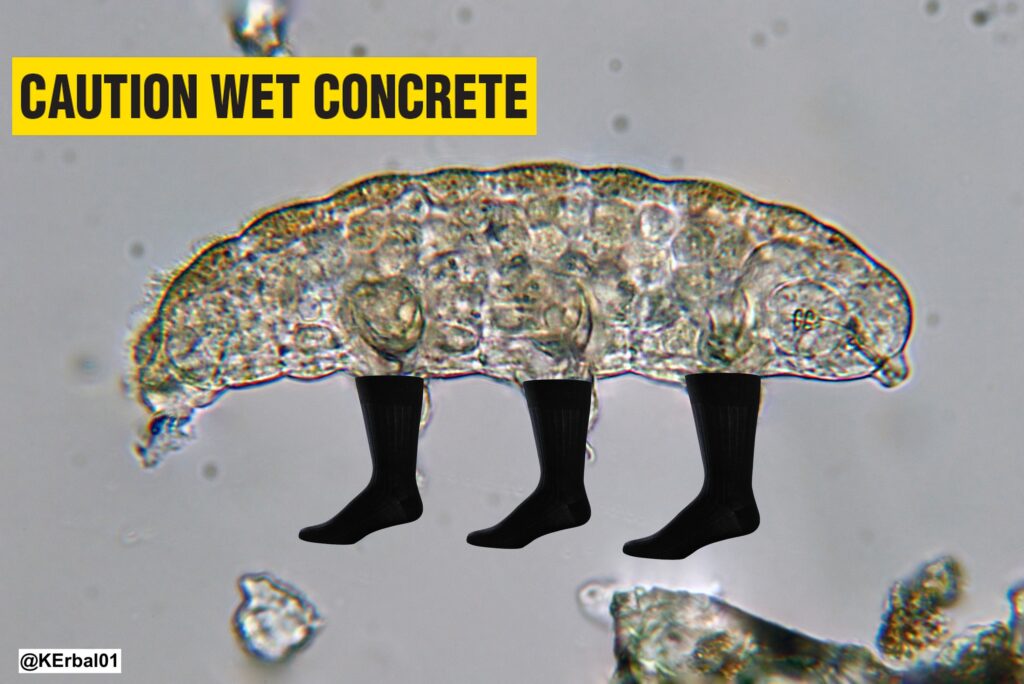
Many experiments were conducted on the ISS. Our favorite experiments last year included sending tardigrades to space (deliberately), and sending dirty “laundry” to be cleaned on the ISS (also deliberately). We couldn’t figure out a way to add space concrete to the mix, but NASA did.
From new human records, to new rockets that will set records in the future.
Several rockets saw their first flights in 2021, and other rockets made it to orbit successfully for the first time.
Astra’s Rocket 3 made two launch attempts in 2021. The first launch in August failed spectacularly when one of the engines shut off at liftoff, resulting in the rocket moving sideways until it had burned enough propellant that it was light enough to go upwards, only to fail later in the flight. The next attempt in November 2021 was successful.
The American aerospace company Firefly launched their Alpha rocket in early September. Sadly, it was doomed by an engine failure seconds after liftoff. The Alpha flew for a few minutes but lost control at Max-Q and was detonated by the range safety officer.
In October, South Korea launched their first domestically developed orbital rocket, the KSLV-II. Unfortunately, the third stage shut off early and it did not reach orbit.
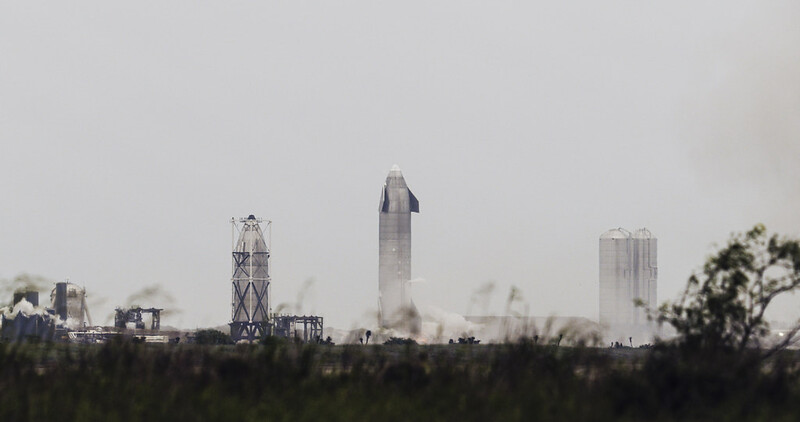
Although it’s not an orbital launch, we can’t not talk about SpaceX’s Starship program. SpaceX continued its mid altitude demonstration program with several launches of vehicles SN9, 10, 11, and 15. Most of these attempts ended in a large explosion, but SN-15 landed in one piece and did not explode post landing. In August 2021, SpaceX stacked the SN-20 and Booster 4 vehicles on the Orbital Launch Mount, assembling for the first time what will become the world’s largest rocket. This was a proof of concept as neither stage was flight worthy. The vehicle was un-stacked the same day.
SpaceX still has lots of work to do to be ready for an orbital launch attempt of the Starship vehicle, including finishing the rocket, its launch complex, and getting approval from several US Government agencies to conduct the launch.
NASA’s Space Launch System was finally fully assembled in the Vehicle Assembly Building after the completion of testing on the vehicle’s large Core Stage. Like Starship, SLS also has lots of work left to do before launch. It will send NASA’s Orion spacecraft out to an orbit around the Moon on a two-week uncrewed mission to demonstrate its fitness for humans. The first crewed launch is scheduled for later this decade.
From rockets that launched for the first time to other spacecraft that finally launched in 2021.
2021 was also the year several long delayed space missions finally launched. The plan and some hardware for Nauka dates back to 1995.
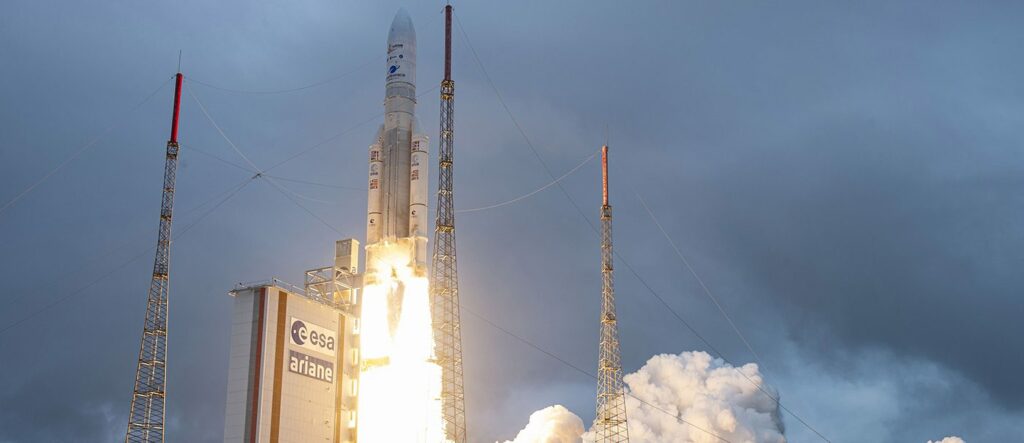
On Christmas Day, the JWST finally left Earth onboard one of the last Ariane 5 rockets, much to the annoyance of scicommers everywhere, who had to wake up ridiculously early to cover the launch. However, it did make for a memorable Christmas morning.
The solar panel deployed a bit earlier than the public timeline suggested, but NASA explained that the observatory was able to stabilize its orientation sooner than expected after separation from the Ariane 5 second stage.
As of the recording of this episode, the spacecraft had completed the process of tensioning its five layer sunshield. With the deployment of the sunshield layers completed, most of the single point of failure events are over with. The spacecraft is healthy and the mirror deployments will come next week. Once the mirrors are deployed, the eighteen individual segments of the primary mirror will be carefully aligned with the secondary mirror. It will take about five months to finish calibrating the instruments before releasing images that make use of the telescope’s full potential. However, we will likely see some calibration images in a few weeks’ time. And when they’re released, you can learn all about them from us.
This has been the Daily Space.
You can find more information on all our stories, including images, at DailySpace.org. As always, we’re here thanks to the donations of people like you. If you like our content, please consider joining our Patreon at Patreon.com/CosmoQuestX.
Credits
Hosts: Pamela Gay and Erik Madaus
Writers: Gordon Dewis, Pamela Gay, Erik Madaus, and Annie Wilson
Audio and Video Editing: Ally Pelphrey
Content Editing: Beth Johnson
Executive Producer: Pamela Gay
Intro and Outro music by Kevin MacLeod, https://incompetech.com/music/


 We record most shows live, on Twitch. Follow us today to get alerts when we go live.
We record most shows live, on Twitch. Follow us today to get alerts when we go live.